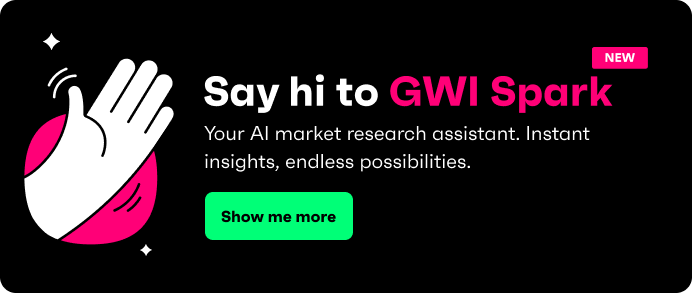
Knowing your audience? Essential. Brands that deeply understand who their customers are and what motivates them consistently outperform competitors.
Just look at Spotify. Their annual “Wrapped” campaigns don’t just delight us; they tap into a deep audience understanding, turning personal listening data into a global cultural moment.
Audience insights go far beyond age or gender. You can learn about motivations, behaviors, and the "why" behind every decision. Having detailed consumer insights on hand gives you clarity, ensuring every strategy, message, and campaign really hits the spot. Today we’ll explore how.
What is a target audience, really?
A target audience is the specific group of people most likely to respond positively to your brand’s products, messaging, or services.
Traditional methods often rely on demographic factors like age, gender, or location. We can now go far beyond these audience definitions, looking into more detailed behaviors, like interests, values, lifestyles, and the why behind their choices.
Simply put, it’s about understanding people as individuals, not just data points.
Why accurately defining your target audience matters for brands
When you don’t know who you’re talking to it shows - in the numbers and the results.
Campaigns fall flat, budgets get stretched thin, and your marketing isn’t landing. You might see low engagement, lower conversion rates, and sometimes even damage to reputation. In fact, Rakuten has reported that up to 26% of marketing budgets are wasted on poor targeting annually. Yikes.
When you lean in to understanding your audience - what they care about, how they behave, and why they buy - everything just works that much better.
Engagement goes up, conversions follow, and loyalty becomes something you can actually count on.
How consumer insights transform target audience identification
Consumer insights offer businesses deeper, actionable views of their target audience.
They unlock the why behind people’s decisions. It’s not enough to know your audience is mostly women aged 25-34. You need to understand what drives them: Are they motivated by convenience? Are they health-conscious? Do they discover new products through TikTok or friends’ recommendations?
That’s where tools like GWI come in. They go beyond demographics to reveal real behaviors, interests, and mindsets.
For example, a food delivery app might learn that its most loyal users aren’t just busy professionals, they’re time-starved parents who value speed over selection and tend to order right after school pick-up. That kind of detail transforms how a brand shapes messaging, designs campaigns, and chooses where to show up.
Audience segmentation beyond demographics
Demographics tell you who your audience is, but not why they care. Real impact comes from understanding values, habits, and motivations.
For example, a luxury travel brand targeting eco-conscious consumers might start with broad demographics like age and income. But with GWI, they can go deeper, identifying travelers who book sustainable stays, follow eco-tourism influencers, and prefer experiences over possessions.
That insight helps the brand create campaigns that actually resonate, highlighting things like carbon-neutral travel or local, ethical experiences, not just generic luxury.
Leveraging on-demand consumer insights
Consumer behaviors shift quickly. Brands relying on static reports can fall behind, but brands with real-time, on-demand insights stay agile.
Platforms like GWI give access to fresh consumer data instantly, keeping marketing strategies clean, correct, and relevant.
When consumer attitudes shift rapidly, like an increased focus on affordability during economic downturns, brands using GWI can adapt messaging fast, maintaining audience engagement and preventing wasted ad spend.
Using GWI’s platform to define and engage your target audience
GWI’s consumer insights platform gives advertisers, marketers, agencies, and strategic decision-makers with the tools to define and deeply understand their audiences.
Let’s run through how the platform allows you to make confident, informed marketing decisions.
Audiences: Pinpoint who matters most
GWI’s Audiences feature gives detailed insights into specific consumer segments. Marketers can create precise, actionable audience segments based on behaviors, interests, and attitudes.
For example, a health brand wanting to target young fitness enthusiasts can quickly define an audience based not only on age and location, but also on activities, media preferences, and digital habits. This granularity makes targeting significantly more effective and strategic.
Dashboards and charts: Visualizing audience insights clearly
You don’t need to be a data analyst to make sense of your audience. GWI’s Dashboards and Charts features turn complex data into clear visuals, so marketers, execs, and media planners can quickly spot trends, share insights, and align on strategy.
Whether it’s identifying a new growth audience or tracking sentiment shifts, the visuals make it easy to get everyone on the same page.
Crosstabs: Going deeper into audience behavior
Crosstabs let you dig beneath the surface by layering data points to reveal deeper audience insights.
Say a retailer’s launching a new eco-friendly product line. They can use Crosstabs to find online shoppers who care about sustainability and value premium quality.
That kind of overlap turns a generic message into one that speaks directly to what people actually care about, driving stronger engagement from the start.
Enhancing audience insights with the API integration
GWI’s API integration delivers consumer insights directly into the tools your teams already use. After all, fresh insights are only useful if your team can access them easily.
This integration brings consumer data straight into the tools your teams are already familiar with, from dashboards to planning platforms. That means no more switching tabs or pulling reports manually.
Whether you're updating audience profiles or tweaking messaging, the data is right there when you need it, helping you move faster and stay relevant.
Target audiences in action: Practical use cases
Clearly defined audience insights elevate businesses across multiple practical use cases. When brands truly understand who they're targeting, their marketing strategies become next-level efficient.
The following examples highlight how GWI’s insights are used in real-world scenarios to drive measurable business outcomes.
Agency pitching and media planning
Agencies stand out when they show they truly get the audience. Say you’re pitching to a sportswear brand targeting fitness enthusiasts. Instead of vague personas, you use GWI to show exactly what drives this group, from their workout routines and wellness goals to the platforms they use most.
Armed with that intel, you build a pitch with tailored messaging, smart media choices, and creatives that hits home. The client sees you’ve done your homework, and trusts you to deliver.
It’s the kind of insight that wins pitches, sharpens media plans, and builds long-term partnerships.
Content strategy and audience alignment
Content only works if it connects. Take a sustainable beauty brand seeing a dip in social engagement. With GWI insights, they realize their audience is shifting toward short-form videos about eco-friendly habits and real customer stories.
So, they pivot. They create bite-sized content on sustainable sourcing and everyday tips. Engagement picks back up, and conversions follow. When your content reflects what your audience actually wants, relevance and ROI go hand in hand. Nice.
Sponsorship and partnership decisions
Picking the right sponsorship isn’t guesswork.You need to know where your audience shows up. Say a beverage brand is torn between backing a music festival or an esports tournament. With GWI insights, they see their core customers lean heavily into gaming.
Instead of rolling the dice, they go all in on esports: and it pays off. Awareness grows, brand affinity climbs, and the spend actually delivers. The right data turns a risky call into a smart move.
Best practices: How to effectively define your target audience with data
Effectively defining your audience involves more than pulling demographic data. To get the most value from your insights, follow these key best practices:
Start with clear business questions
Audience research should always support clear business objectives. Before collecting data, define exactly what your business aims to achieve.
For example, if you’re trying to grow market share with young professionals, don’t stop at age or job title. Look into what drives them. Their career goals, daily routines, and how they spend time online.
Keep audience segments specific and actionable
Audience segments should always be clearly defined and practically useful. Instead of broad, general groupings, strive for detailed segments that directly inform marketing actions.
For example, don’t just target “young women into fitness.” Get specific: “Women aged 25-35 who take boutique workout classes, follow wellness influencers, and shop online for activewear.”
The more precise your segment, the more your message hits, and the better your results.
Leverage integrated data across platforms
Integrating audience data across your marketing tools helps keep insights fresh, relevant, and easily accessible.
With GWI’s API integration, your team gets fresh consumer insights right inside the tools they already use. No switching tabs or digging for data. Just faster decisions, consistent messaging, and the ability to pivot when trends shift.
Frequently asked questions on target audiences
What is a target audience?
A target audience is a clearly defined group of consumers most likely to respond positively to your brand’s products or messages. Effective target audiences are defined not only by demographics but also by interests, behaviors, and values.
How do you find your target audience?
Brands identify target audiences by using comprehensive consumer research tools like GWI. These platforms enable detailed segmentation based on consumer behaviors, attitudes, motivations, and lifestyles, ensuring precise targeting.
Why is understanding your target audience important?
Deeply understanding your audience helps your marketing resonate more effectively, reduces wasted advertising spend, increases conversion rates, and builds stronger brand-consumer relationships.
Final takeaway: Unlock your brand’s potential with the right audience insights
Knowing your target audience inside and out gives your brand the confidence to connect meaningfully. GWI’s real-time consumer insights help you adapt quickly, target smarter, and stay relevant as your audience evolves. Brands that lean into this data-driven approach build stronger connections, grow sustainably, and turn audience understanding into real results.





.webp?width=495&height=317&name=pink_thumb_graphs%20(1).webp)
.webp?width=495&height=317&name=pink_thumb_letter%20(2).webp)